Running Facebook Product Ads on the world’s most extensive social network is an essential medium that helps you connect with your audience daily.
According to Statista, we’re talking 2.9 billion monthly active users.
Heck, that sure is a monumental figure. But managing Facebook Product ads is all about getting your message in front of the right people –People who want your products or services.
This carefully crafted guide will walk you through everything you need to know, from planning your Facebook product ads to developing some pro-level marketing strategies.
These ads are a great way to get started with Facebook paid advertising. With just a few clicks, you boost an existing post with an image from your Facebook page.
These may be straightforward, but they don’t necessarily have to be all boring. For example, domain names may seem tedious, but we have the Canadian Internet Registration Authority, who created some fun and creative Facebook photo ads.
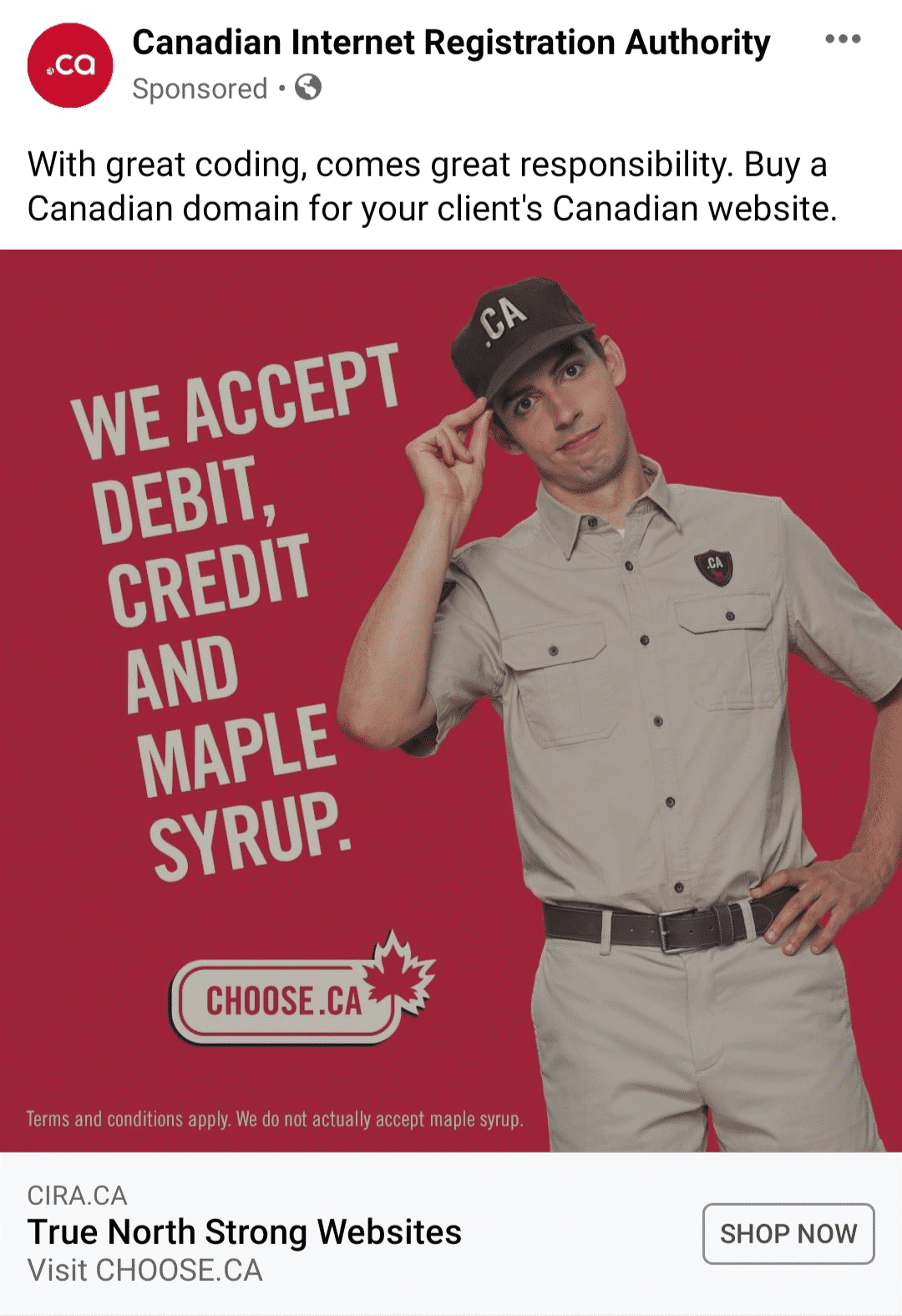
- Video Ads
Video ads whisk through the News Feed and Stories or emerge in the in-stream ads in longer Facebook videos. They present your product or your team in action.
For instance, we have this quick video ad from Abeego.

And just like image ads, they can take an innovative approach too, like this one from Tru Earth:
Secondly, they don’t always have to be video footage. You can use GIFs or some other sort of animation to grab attention and explain your offer. Let’s take a look at this IKKEA ad for better clarity.
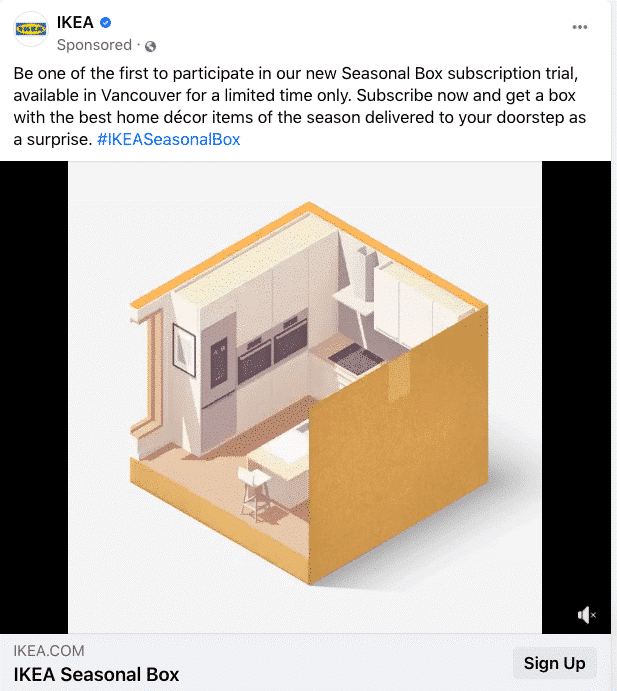
- Poll ads
This mobile-only ad configuration consolidates an interactive component by introducing a two-option poll to a video or an image ad. A separate link can be added for each poll option.
Those who respond will see a percentage of answers for each poll option.
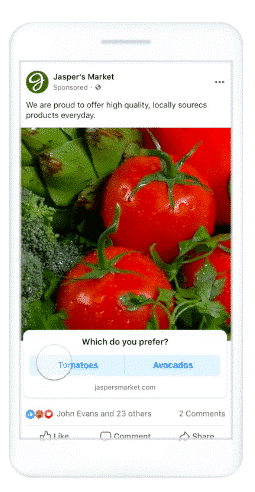
- Carousel Ads
This ad format uses ten images or videos to display your service or product.
You can use this setup to highlight various pros of a product, multiple products, or combine all the photos to create a large panorama image.
Each image or video can have its link. In the example below, every “Shop Now” button takes the end-user directly to the sales page for the product.
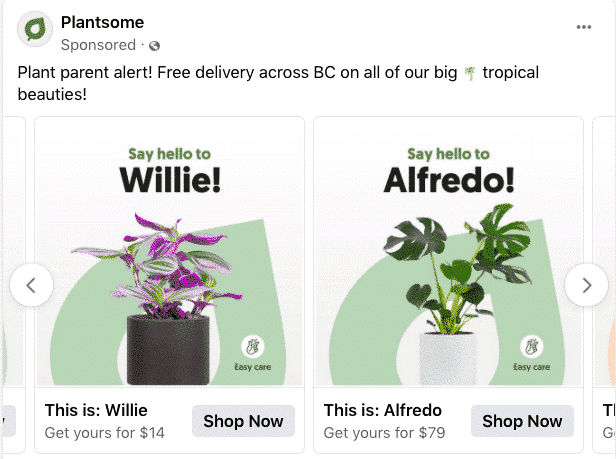
- Slideshow Ads
Slideshow ads offer a painless approach to creating short videos from various still photos, video clips, or text.
They have a conspicuous gesture, just like videos but use five times less data. Meaning they load up quickly for people with snail-speed internet.
You can create your ads and add text and music the way you prefer within Ads Manager.
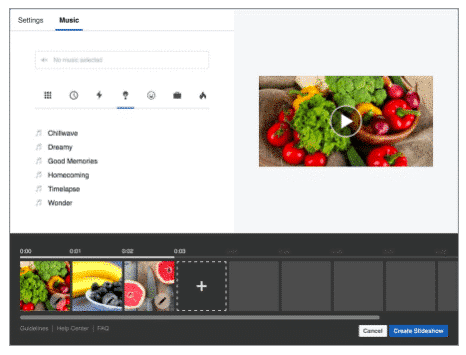
- Collection Ads
These paid ads, offered only for mobile devices, allow marketers to advertise five images or videos customers can click on to buy a service or product.
Collection ads pair perfectly with Instant experiences and allow customers to buy products without leaving the platform –Facebook. It makes online shopping a breeze when people are short on time.
The “in-the-spotlight” video or photo can do much more than displaying a single product. For example, in the Lee Valley Tools ads, the main video demonstrates selecting the right seeds for the garden. And the images below all aim towards supplies for planting and saving seeds.
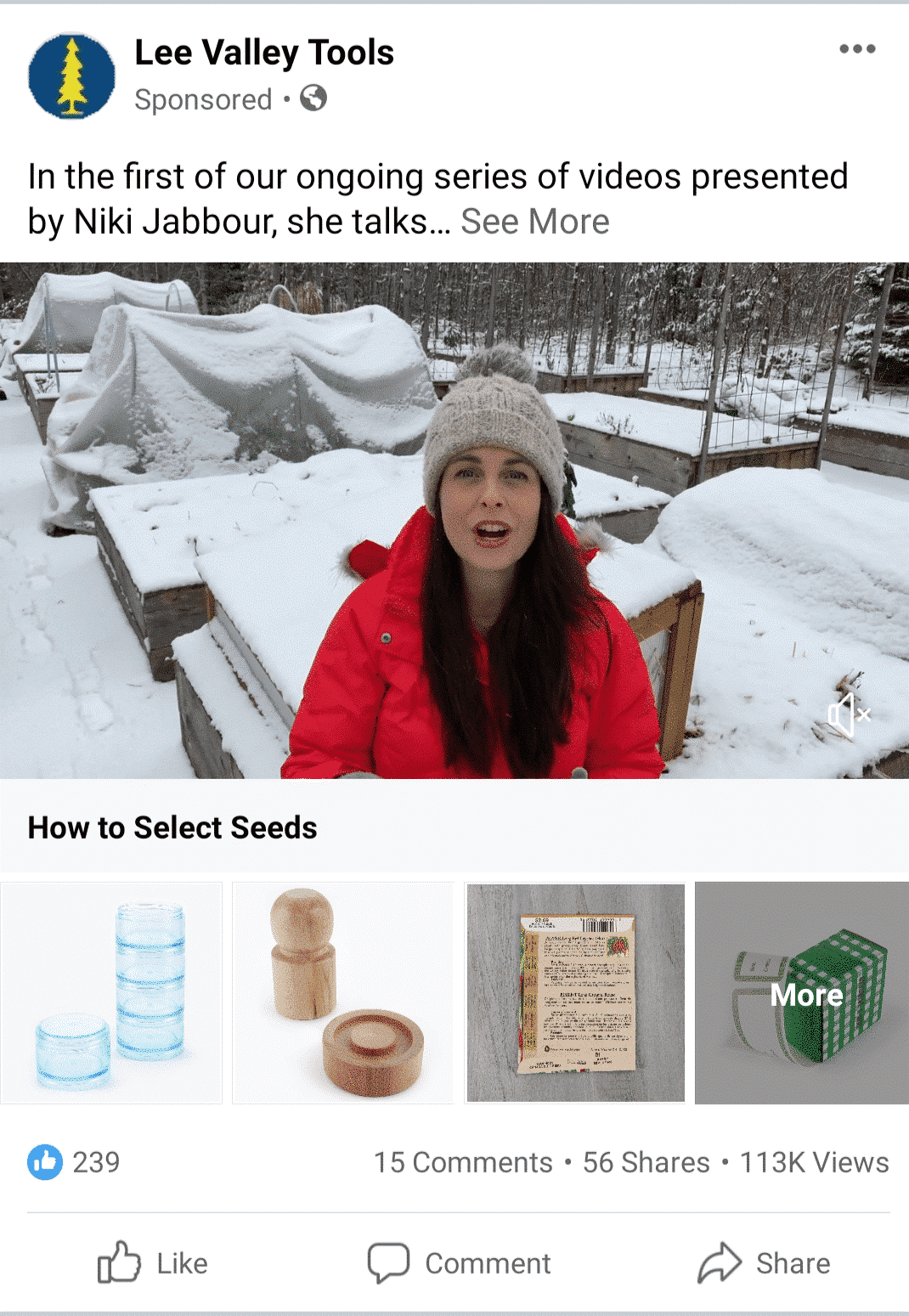
- Lead Ads
Just like collection ads, these are restricted to mobile devices. The reason is; to make it feasible for people to send in their contact info without much typing.
Lead Ads come in handy when collecting newsletter subscriptions, signing customers up for product trials, or allowing customers to ask for more information from the advertiser.
Several automakers have profitably used them to encourage test drives.
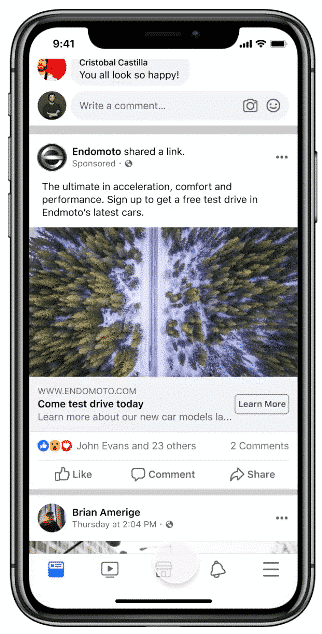
- Dynamic Ads
With the help of Dynamic Ads, marketers can promote products to customers who are most likely interested in them.
For example, someone visited your website and put a product in their shopping cart, but someone took a U-turn and abandoned the purchase. With dynamic ads, you advertise that same product in their Facebook feed, luring someone into completing the purchase.
This can also be an effective Facebook product ads strategy.
However, it’s not just limited to product selection; looking at Taiwanese Beverage Brand “Nature Fruit,” used dynamic ads to control language settings for its ads when it reached out to Malaysia—enabling them to lower the cost by 25% per add-to-cart.

From a beginner’s point of view, we think we’ve covered enough of the Facebook ad types, and now it’s time to move on to the next-in-line topic.
How to Advertise on Facebook
Assuming that you already have a Facebook Business Page (and you should), you can head to the Facebook Ads Manager or Business Manager to launch your ad campaign.
We’ll be following the steps for Ads Manager, but if you’re one of those stubborn sellers and prefer sticking to the Business manager portal, we have a separate guide to get you through.
Step 1: Choose an objective
Start by logging in to the Facebook Ads Manager, selecting the campaigns tab, and clicking create to get started with a new Facebook Ad Campaign.
Select a campaign objective that aligns with your goals. Remember that for objectives like Sales (conversion-oriented), you can pay per action. And for traffic and views objective (exposure-oriented).
Here, we’ll be going with the engagement objective. We need to mention the type of engagement; we’ll select Page Likes.
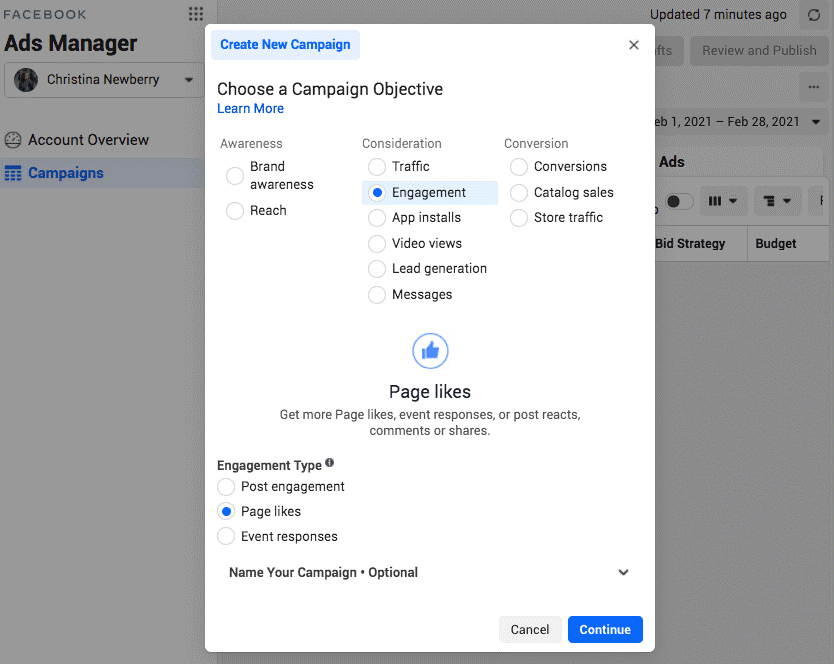
Step 2: Name your Campaign
Now is the time to make it official; Name your Facebook ad Campaign and define whether or not it falls under any special categories like credits or politics.
Setting up the A/B test is your call. You can select different versions of this ad after it goes live to understand better which strategies give you the best results.
Scot down a little, and you’ll see the budget optimization option. This can be convenient if using multiple ad sets.
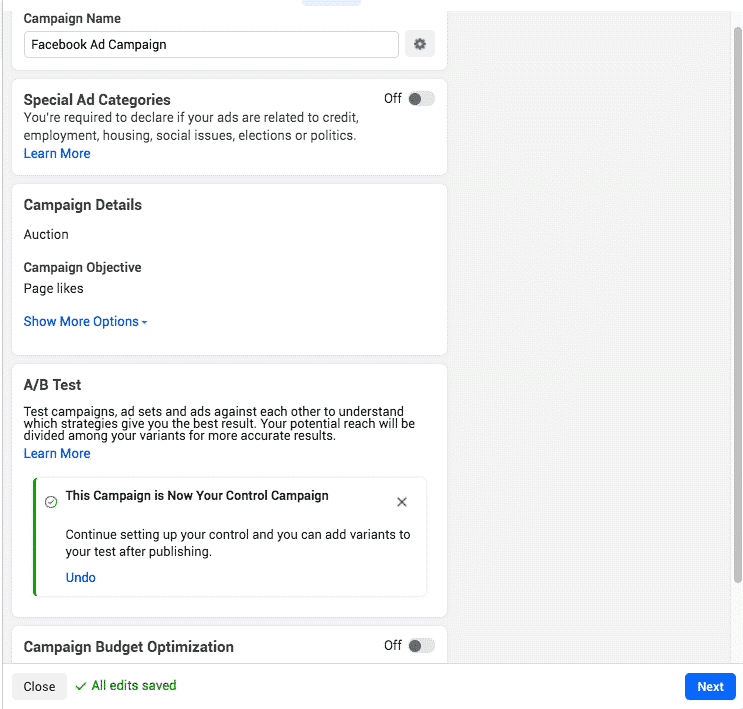
Step 3: Choose a budget and schedule
At the top, you’ll name the ad set and select which page to promote on this screen.
Next, you’ll decide how much money you want to spend on your Facebook Ad Campaign. You have the option to select a daily or a lifetime budget. Specify start and end dates, or make it live straight away.
A word of advice here. When running paid ads, setting a schedule is a practical approach to managing your budget since you get to run your ad when the target audience is most likely to be active on Facebook. One thing more, the schedule only comes with the lifetime budget option.
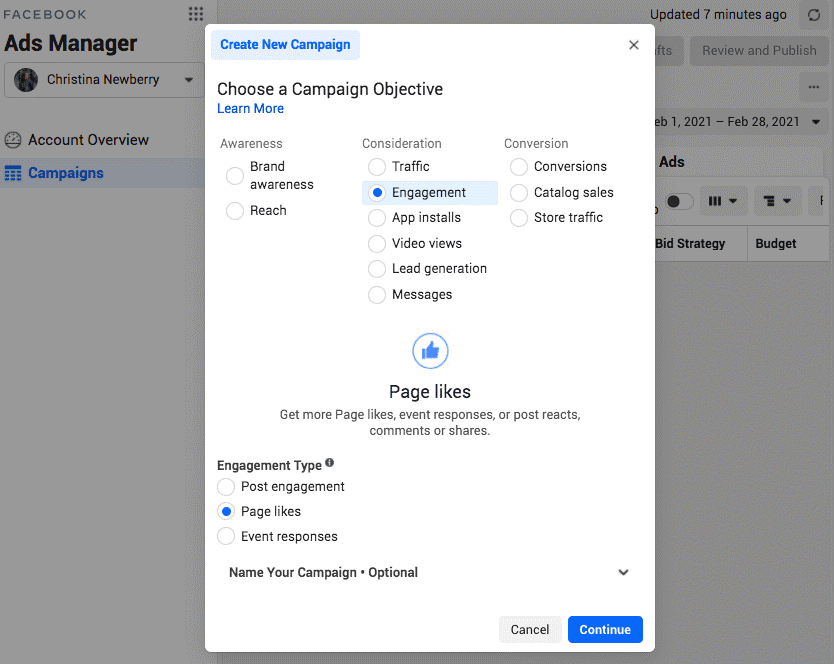
Step 4: Target your audience
Scroll down, and you’ll have the option to start building the target audience for your ads.
The first option you’ll encounter is to add a custom audience of people who have already interacted with your business. For Facebook custom audiences, we have a separate guide where we’ll concentrate on targeting options.
Start by choosing the target location, gender, age, and language. As you go on with the choices, keep an eye out for the audience size indicator on the right; it predicts an ad’s potential reach.
You’ll be looking at the estimated number of page likes. These will be accurate if you have run campaigns in the past.
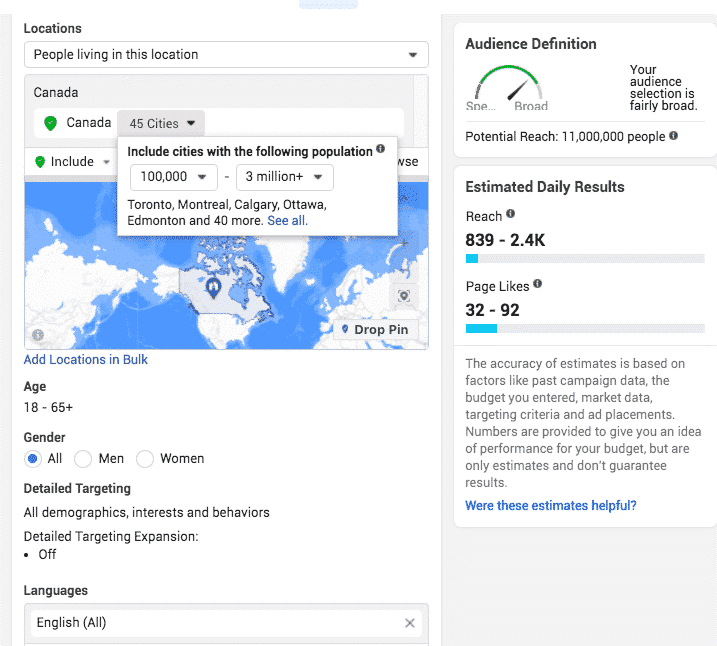
Step 5: Select your Facebook Ad placements
Scroll down, and you’ll be given the options for ad placements. The best option is the Automatic Placements if you’re new. As the name suggests, with this option, Facebook automatically scrambles your ads across itself, Instagram, Messenger, and other platforms where they are expected to get good results.
If you’re a seasoned advertiser, you may wish to choose the ads placements in specific locations.
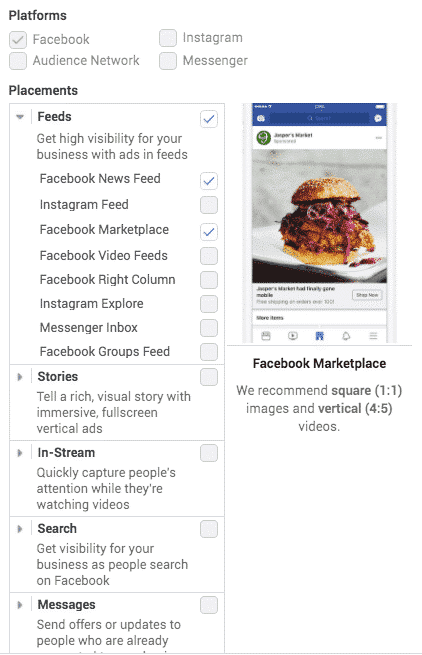
Step 6: Define brand safety and cost controls
Now comes the Brand safety section. Here you can exclude any content that would be inappropriate to show up with your ad.
For instance, you can select to ward off sensitive content and include specific blocklists. These lists can exclude certain websites, publishers, and videos.
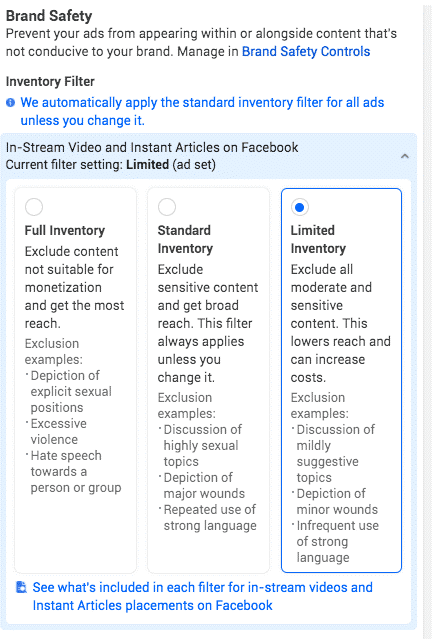
Finally, you can develop an ad bidding strategy and bidding type and introduce optional bid control. If you’re new, go with the default settings.
And if you’re an experienced marketer, customize the options according to your budget and campaign goals.
Once satisfied with your preference, click Next.
Step 7: Create your Ad
Select the ad configuration and input the text and media components for the ad. The options will vary, depending on the campaign objective selected right at the start. After this, there’ll be no more steps.
You can show your creative side here. If working with photos, try clicking Turn into Video, or Create Slideshow to assemble a slideshow ad with the built-in video creation kit.
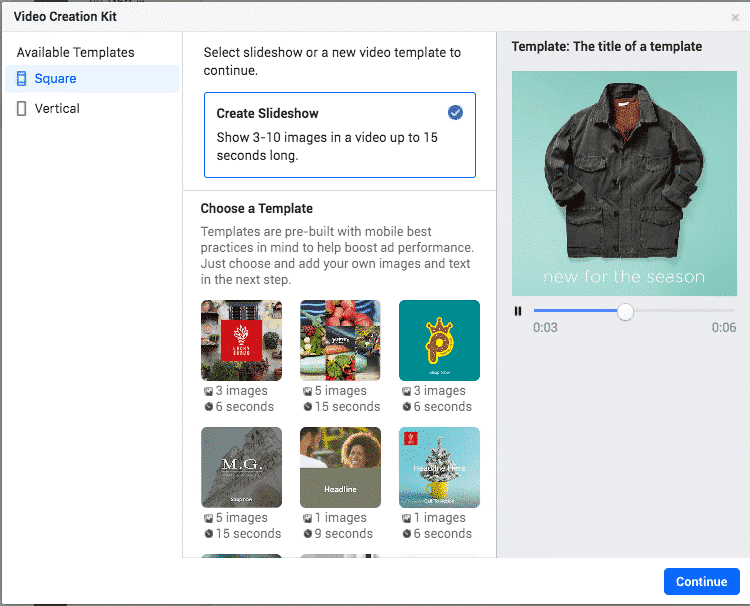
Facebook ads cost
Now, it’s time to look into the cost of these ads. After all, Facebook product ads don’t run for free.
The cost to advertise on Facebook depends on various factors, and these are according to in-depth research by AdEspresso:
- Timing: The month, day, and hour can alter the ad cost.
- Bidding Strategy: Depends on whether you go with the lowest or a specific bid cap.
- Ad Placements: When the competition is tough, so is the cost.
- Ad Relevance: Ad relevancy score affects the cost as well.
- Target Audience: Greater competition audience costs more.
Facebook Advertising Tips
Following are some tips that will prove worthy in running your next Facebook Products ad strategy.
- When you observe that the best-performing ad sets are no longer keeping up to expectations, clone them and restart. This way, you’ll possibly get a good ROI again.
- Start with a slightly higher budget. Not that Facebook will take all your daily budgets initially, but you won’t have to worry about adjusting it if the ad set works.
- Before taking down your ad set, try replacing the ad’s image you’re using. Change the image, wait a few days, and then conclude. Experts say that it mostly boils down to Banner blindness which causes low ROI.
Time to roll the credits
Well, there you have it.
Congratulations! You have just made it to the other end of the Facebook Products ad strategy guide. Now that you know all the Facebook advertising tactics for beginners, you’re ready to start melting faces –promote your eCommerce products.
Moreover, it would help if you were comfortable surveying your campaign performance by reviewing various performance metrics. For example, CTA rates, CPC, and breakdowns, which in return will lead to much better marketing decisions.
